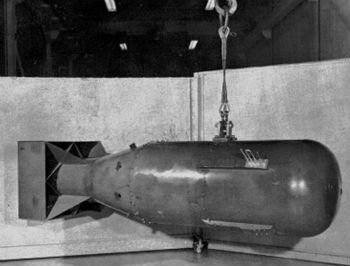Atomic bomb, or nuclear bomb, is a weapon that consists of an explosive projectile launched by airplanes or missiles.
It works as a result of nuclear fusion and fission processes and has a high destructive power.
Historical Aspects

Fearful of the Nazis’ persecution of Jews, several scientists have moved to the United States. Among them, stands out Albert Einstein who took a chair at the Institute for Advanced Studies in Princeton.
Along with Hungarian physicist Leo Szilard, Einstein warned President Franklin Roosevelt of the possibility that the Nazis could develop an atomic bomb.
They believed that the United States should anticipate this movement and fund research that would lead to the discovery of the atom’s fission.
In the sequence, the Manhattan Project was initiated , responsible for the creation of the atomic bomb directed by the American physicist Julius Robert Oppenheimer .
The scientists used Albert Einstein’s research as a basis for the development of atomic energy.
Before the atomic bomb was launched, the nuclear weapon was tested on July 16, 1945 in the desert of New Mexico (USA).
Second World War
To date, the atomic bomb has been used in only two situations during World War II.
In World War II , countries split. On the side we find an alliance formed by Germany, Italy and Japan; and the other by Great Britain, the Soviet Union and the USA.
In 1945, Germany and Italy had already surrendered. Nevertheless, the war continued in the Pacific where Japan and the United States fought a hard fight of conquest island by island.
War in the Pacific
In 1941, Japan had attacked Pearl Harbor , the American naval base, without any declaration of war being made to the USA. Therefore, the Americans fought against the Japanese in the Pacific.
The Americans realized that Japan would not surrender and judged an invasion of the country very costly in human and financial terms. Thus, the military decided to drop the atomic bomb in Japan to force surrender.
In this way, the Hiroshima Bomb was launched on August 6, 1945 by the American bomber aircraft Enola Gay .
The bomb was named Little Boy and detonated the city of Hiroshima, in Japan, 580 meters high. The city was destroyed and about 140,000 people died.
Many people died at the time of the explosion, while others died as a result of the consequences left by the nuclear weapon.
Days later another bomb was dropped on Nagasaki. His name was Fat Man, he destroyed much of the city and killed about 70,000 people.
The Fat Man was more potent than the Little Boy , although their damage was lower. This happened because the city is located in a mountainous region.
Japan surrendered on September 2, 1945.
Destruction Power

In the cities of Hiroshima and Nagasaki, the air became a kind of fireball that expanded rapidly.
As a result of the large amount of thermal energy that was released, this ball was as hot as the surface of the Sun. As a result, everything that was within a radius of 1 km turned into ashes.
The soil also overheated. The gases expanded causing a shock wave causing the fall of 62,000 buildings in Hiroshima. The city had 90,000 buildings.
The effects caused by radiation were burns, breathing problems, mental disorders, physical deformities and cancer in thousands of people.
Those who looked at the explosion went blind and there was radioactive rain that contaminated the water and the soil. For years people have suffered from the effects of bombs.
After the bombs were dropped in Hiroshima and Nagasaki, nuclear weapons continued to be developed.
There are thousands of weapons even more powerful than those that were dropped on Japan in World War II. Most of them belong to the USA and Russia.
The UN is responsible for regulating global nuclear policy. Likewise, the Treaty on the Non-Proliferation of Nuclear Weapons (NPT) is an agreement through which the signatory countries undertake to use nuclear energy for peaceful purposes.
Chemical Aspects
The bomb dropped in the city of Hiroshima had two charges composed of 235 uranium, for a total of about 60 kg.
The bomb dropped on Nagasaki was composed of about 6.4 kg of plutonium 239. This element arises from the transformation of uranium 238.
The uranium 235 ( 235 U) and plutonium 239 ( 239 Pu) are elements that have a fairly high energy potential and, therefore, represent a great danger.
How does the Atomic Bomb work?
The bombs dropped on Japanese cities resulted from the fission process. Another process that results in the operation of nuclear bombs is fusion.
Fission is breaking the nucleus of the atom. A neutron reaches the nucleus of the atom and breaks. In a process that happens at high speed, other neutrons reach other nuclei.
Fusion is the joining of the nucleus of two or more atoms.
These processes release a high and extremely potent amount of energy. This is the reason why the explosion occurs.
The most powerful pumps that have the greatest destructive power are those that contain hydrogen. They are known as H pumps or pumps of melting because this is how they work.
Brazilian Nuclear Weapons
Although Brazil has the capacity to produce nuclear weapons, the country reneged on the right to have them through the signing of several international treaties.
In 1979 a secret project called Programa Paralelo had been started . This program was intended to develop weapons of mass destruction and was only announced to Brazilians in the 1990s.
It was a project that would be able to produce atomic bombs more powerful than those launched in Hiroshima and Nagasaki, but it was dismantled. Share Submit Email
